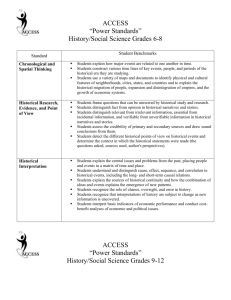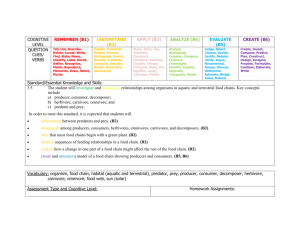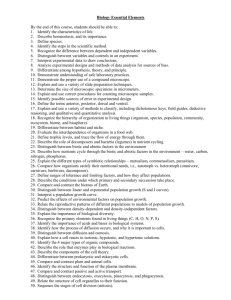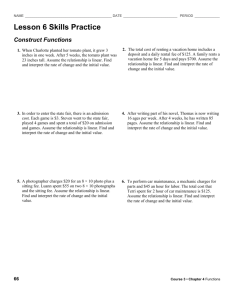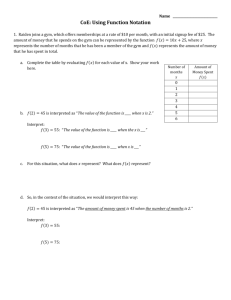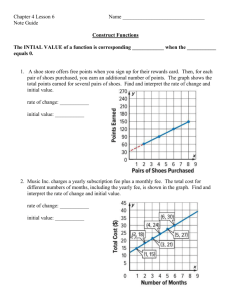ISCI 2001 Instructio..
advertisement
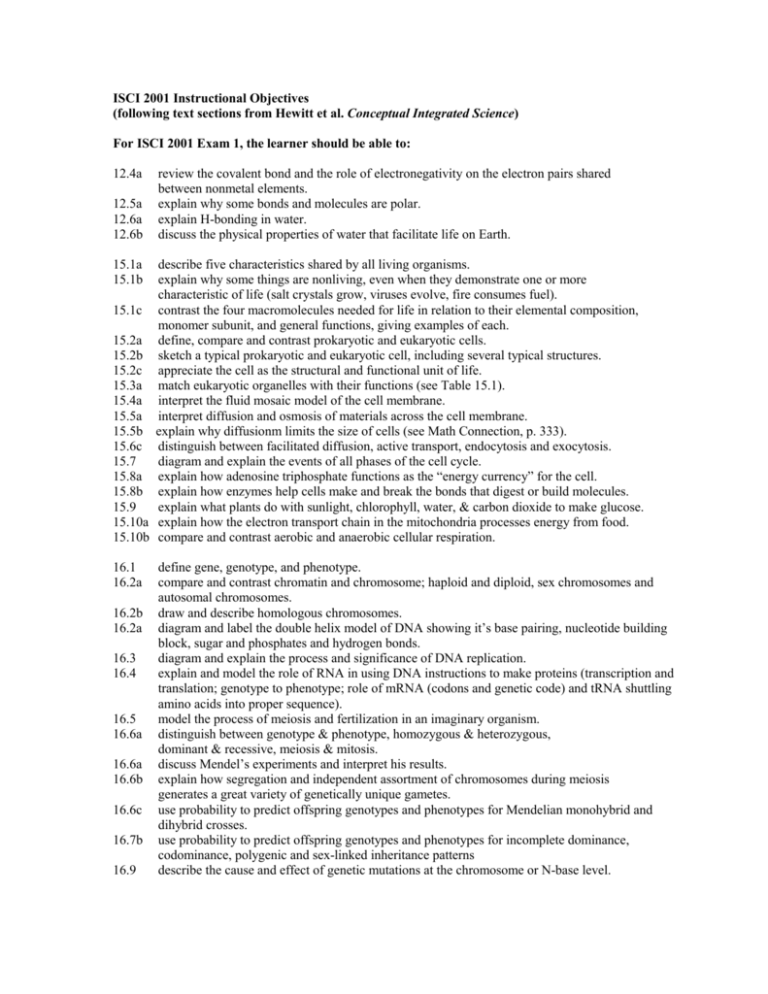
ISCI 2001 Instructional Objectives (following text sections from Hewitt et al. Conceptual Integrated Science) For ISCI 2001 Exam 1, the learner should be able to: 12.4a 12.5a 12.6a 12.6b 15.1a 15.1b 15.1c 15.2a 15.2b 15.2c 15.3a 15.4a 15.5a 15.5b 15.6c 15.7 15.8a 15.8b 15.9 15.10a 15.10b 16.1 16.2a 16.2b 16.2a 16.3 16.4 16.5 16.6a 16.6a 16.6b 16.6c 16.7b 16.9 review the covalent bond and the role of electronegativity on the electron pairs shared between nonmetal elements. explain why some bonds and molecules are polar. explain H-bonding in water. discuss the physical properties of water that facilitate life on Earth. describe five characteristics shared by all living organisms. explain why some things are nonliving, even when they demonstrate one or more characteristic of life (salt crystals grow, viruses evolve, fire consumes fuel). contrast the four macromolecules needed for life in relation to their elemental composition, monomer subunit, and general functions, giving examples of each. define, compare and contrast prokaryotic and eukaryotic cells. sketch a typical prokaryotic and eukaryotic cell, including several typical structures. appreciate the cell as the structural and functional unit of life. match eukaryotic organelles with their functions (see Table 15.1). interpret the fluid mosaic model of the cell membrane. interpret diffusion and osmosis of materials across the cell membrane. explain why diffusionm limits the size of cells (see Math Connection, p. 333). distinguish between facilitated diffusion, active transport, endocytosis and exocytosis. diagram and explain the events of all phases of the cell cycle. explain how adenosine triphosphate functions as the “energy currency” for the cell. explain how enzymes help cells make and break the bonds that digest or build molecules. explain what plants do with sunlight, chlorophyll, water, & carbon dioxide to make glucose. explain how the electron transport chain in the mitochondria processes energy from food. compare and contrast aerobic and anaerobic cellular respiration. define gene, genotype, and phenotype. compare and contrast chromatin and chromosome; haploid and diploid, sex chromosomes and autosomal chromosomes. draw and describe homologous chromosomes. diagram and label the double helix model of DNA showing it’s base pairing, nucleotide building block, sugar and phosphates and hydrogen bonds. diagram and explain the process and significance of DNA replication. explain and model the role of RNA in using DNA instructions to make proteins (transcription and translation; genotype to phenotype; role of mRNA (codons and genetic code) and tRNA shuttling amino acids into proper sequence). model the process of meiosis and fertilization in an imaginary organism. distinguish between genotype & phenotype, homozygous & heterozygous, dominant & recessive, meiosis & mitosis. discuss Mendel’s experiments and interpret his results. explain how segregation and independent assortment of chromosomes during meiosis generates a great variety of genetically unique gametes. use probability to predict offspring genotypes and phenotypes for Mendelian monohybrid and dihybrid crosses. use probability to predict offspring genotypes and phenotypes for incomplete dominance, codominance, polygenic and sex-linked inheritance patterns describe the cause and effect of genetic mutations at the chromosome or N-base level. For ISCI 2001 Exam 2, the learner should be able to: 17.1a 17.1b 17.2 17.3 17.4a 17.4b 17.4c 17.5d 17.5a 17.5b 17.5c 17.5d 17.6a 17.6b 17.7a 17.7b 17.7c 18.1a 18.1b 18.2 18.3 18.4 18.5 18.6a 18.6b 18.6c 18.7 18.8 21.1 21.2 21.3 21.4a 21.4b 21.5 21.6a 21.6b 21.6c define spontaneous generation and explain Pasteur’s experimental results in this area. state three hypotheses for the origin of organic molecules necessary for life on Earth. compare the roles of prokaryotic heterotrophs and autotrophs in the evolutionary view of early life on Earth. contrast the time prokaryotes have been on Earth with the time in which eukaryotes first appeared. appreciate the human qualities of Charles Darwin and the historical context of his life. discuss Darwin’s voyage on the HMS Beagle and the subsequent work that led to the publication of Origin of Species 21 years later. contrast Lamarck’s evolution theory (inheritance of acquired characteristics) with Darwin’s theory of evolution by natural selection. summarize the observations and inferences that Darwin made regarding survival, reproduction and evolution of populations. define natural selection, and use an example to explain how it works. define biological adaptation, give examples of survival, sexual, & behavioral adaptations. distinguish between directional, stabilizing, and diversifying selection. discuss examples of evolution as changes in the allele frequencies in a population over time (the case of the peppered moth, antibiotic resistance in bacteria). define biological species, and discuss reproductive barriers that keep species distinct. describe how reproductive barriers evolve (allopatric and sympatric speciation). discuss the meaning of the term “scientific theory” and how this differs from the way the term theory is often used in daily conversation. consider homologous structures as evidence for common descent. interpret evolution evidence from biogeography, and paleontology. apply Carl Linnaeus’ system of binomial nomenclature and 7 taxonomic categories. compare Linnaean and cladistic classification (birds as Aves vs birds as Reptilia), and discuss the advantages of the latter. define the three “Domains” of life, and compare these to the “Kingdom” clades. describe bacterial nutrition, cell structure, reproduction and metabolism. distinguish archaea from other prokaryotes. define protists and compare diverse forms relative to cell structure and nutrition. define plants and discuss adaptations that make them suited for life on land. describe alternation of generations in plants, as seen in the moss and fern life cycle. explain how pollen, cones and flowers have contributed to seed plants diversity. describe fungal nutrition, cell structure, and reproduction. define animal and compare the nine major phyla. define ecology and compare the population, community, and ecosystem level of study. discuss species interactions related to trophic levels, competition, and symbiosis. interpret energy flow in ecosystems (primary productivity & energy pyramids) recognize features of eight terrestrial biomes and two aquatic biomes. diagram and explain the chemical cycling of water, carbon and nitrogen. explain ecological succession in its primary and secondary forms. interpret exponential and logistic models of population growth. describe population growth changes as the population approaches carrying capacity. contrast life history strategies of various organisms (r-selection and type III survivorship versus K-selection and type I survivorship). For ISCI 2001 Exam 3, the learner should be able to: 22.1a 22.1b 22.2a 22.2b contrast the catastrophism and uniformitarianism ideas of the Earth. recognize the contributions of Hutton, Smith, and Lyell to Earth Science. define “earthquake.” explain how seismology provides most of what we know about the Earth’s interior (What did the discoveries of Oldham, Mohorovicic, Gutenberg, and Lehman all have in common?) 22.3a describe physical properties of the Earth’s crust, mantle, and core. 22.3b apply the isostacy concept to interpretations of differences in the thickness of Earth crust. 22.4a explain Alfred Wegener’s theory of continental drift 22.4b evaluate the evidence for continental drift, and the limitation of this theory 22.5 discuss ocean discoveries made from the 1940s to 1960s (surprising aspects of underwater topography, deep ocean trenches, the Mid-Atlantic Ridge with seafloor spreading and magnetic stripes). 22.6a explain the theory of plate tectonics. 22.6b use the theory of plate tectonics to explain how new lithosphere is formed at mid-ocean ridges (Fig 22.16) and to explain the forces that drive the plates (Fig 22.21). 22.7 interpret physical processes that occur at divergent plate boundaries. 22.8 interpret physical processes that occur at convergent plate boundaries of three types. 22.9 interpret physical processes that occur at transform plate boundaries 22.10 discuss relevant aspects of earthquakes and tsunamis. 23.1 compare main elements in the whole Earth and Earth’s crust. 23.2 discuss five characteristics of a mineral, as referred to in Earth science. 23.3 distinguish between mineral properties such as crystal form, hardness, cleavage and fracture, color, specific gravity. 23.5a compare and contrast the silicate and carbon tetrahedron 23.5b distinguish silicate minerals from several different types of nonsilicate minerals. 23.6 define “rock” and define the three basic types. 23.7 explain how intrusive and extrusive igneous rocks are formed. 23.8 describe the stages of weathering, erosion, deposition, and sedimentation in the formation of sedimentary rocks. 23.9 explain how metamorphic rocks form, using common examples such as marble, slate, gneiss. 23.10 apply common examples of rocks in an overall “rock cycle”. 24.4,6 discuss the hydrologic cycle and relevant aspects of fresh water 25.1 distinguish between weather and climate 25.2 explain the reason for the Earth’s seasons. 25.4 describe the structure and composition of the Earth’s atmosphere. 25.5 interpret global wind patterns. 25.6 interpret global ocean currents. 25.8 explain how clouds form and distinguish among four major cloud groups. 25.9a compare characteristics of different air masses 25.9b interpret weather events at a cold front and warm front.

